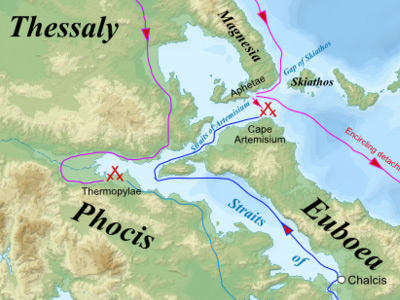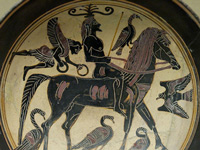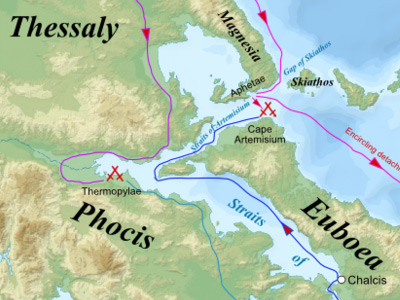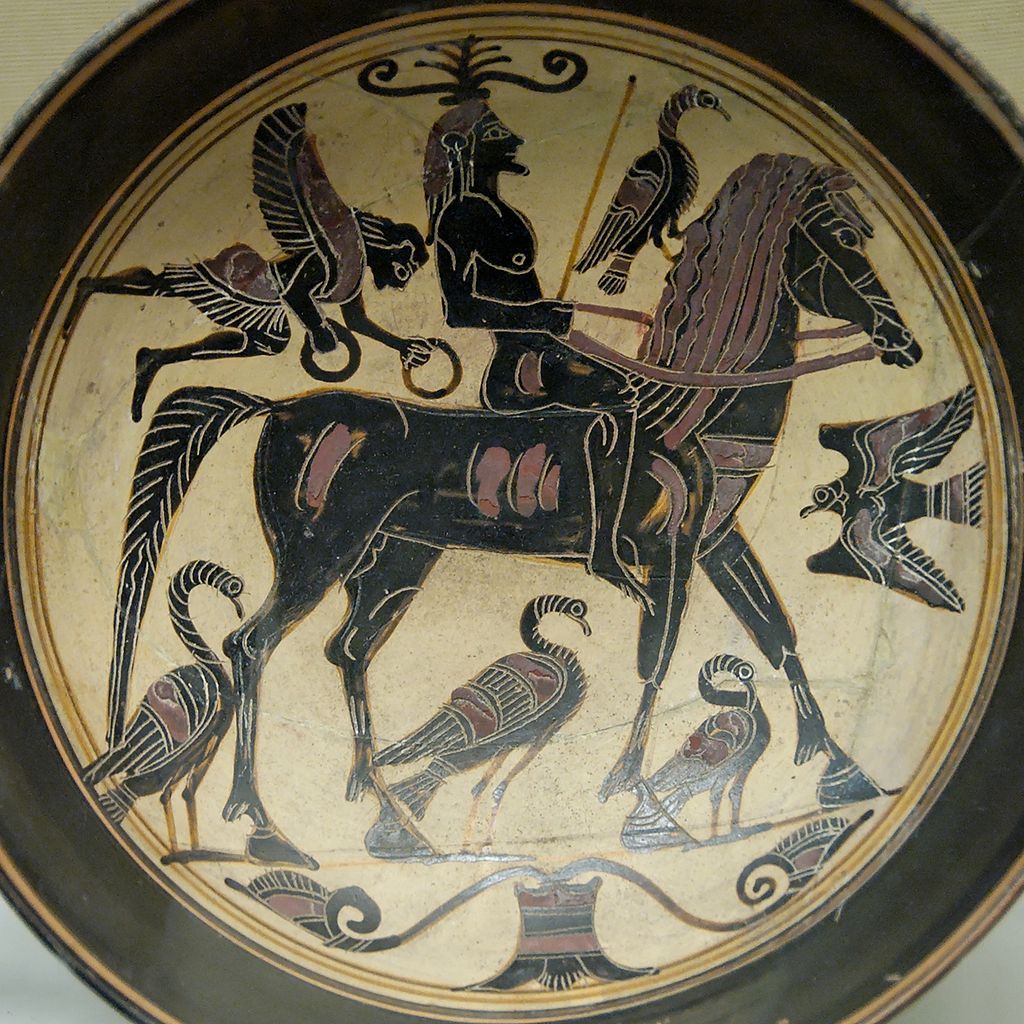Battle of Thermopylae (480 BC)

Third Day
At daybreak on the third day, the Phocians guarding the path above Thermopylae became aware of the outflanking Persian column by the rustling of oak leaves. Herodotus says they jumped up and were greatly amazed. Hydarnes was perhaps just as amazed to see them hastily arming themselves as they were to see him and his forces. He feared they were Spartans but was informed by Ephialtes that they were not. The Phocians retreated to a nearby hill to make their stand (assuming the Persians had come to attack them). However, not wishing to be delayed, the Persians merely shot a volley of arrows at them, before bypassing them to continue with their encirclement of the main Greek force.
Learning from a runner that the Phocians had not held the path, Leonidas called a council of war at dawn. According to Diodorus, a Persian called Tyrrhastiadas, a Cymaean by birth, warned the Greeks. Some of the Greeks argued for withdrawal, but Leonidas resolved to stay at the pass with the Spartans. Upon discovering that his army had been encircled, Leonidas told his allies that they could leave if they wanted to. While many of the Greeks took him up on his offer and fled, around two thousand soldiers stayed behind to fight and die. Knowing that the end was near, the Greeks marched into the open field and met the Persians head-on. Many of the Greek contingents then either chose to withdraw (without orders) or were ordered to leave by Leonidas (Herodotus admits that there is some doubt about which actually happened). The contingent of 700 Thespians, led by their general Demophilus, refused to leave and committed themselves to the fight. Also present were the 400 Thebans and probably the helots who had accompanied the Spartans.
Leonidas' actions have been the subject of much discussion. It is commonly stated that the Spartans were obeying the laws of Sparta by not retreating, but it seems it was actually the failure to retreat from Thermopylae that gave rise to the notion that Spartans never retreated. It is also possible that, recalling the words of the Oracle, Leonidas was committed to sacrifice his life in order to save Sparta. However, since the prophecy was specific to him, this seems a poor reason to commit 1,500 other men to a fight to the death.
The most likely theory is that Leonidas chose to form a rearguard so that the other Greek contingents could get away. If all the troops had retreated, the open ground beyond the pass would have allowed the Persian cavalry to run the Greeks down. If they had all remained at the pass, they would have been encircled and would eventually have all been killed. By covering the retreat and continuing to block the pass, Leonidas could save more than 3,000 men, who would be able to fight again.
Advertisement

These books are available for download with iBooks on your Mac or iOS device, and with iTunes on your computer. Books can be read with iBooks on your Mac or iOS device.

These books are available for download with iBooks on your Mac or iOS device, and with iTunes on your computer. Books can be read with iBooks on your Mac or iOS device.
( Click image to enlarge)
The Thebans have also been the subject of some discussion. Herodotus suggests they were brought to the battle as hostages to ensure the good behavior of Thebes. However, as Plutarch long ago pointed out, if they were hostages, why not send them away with the rest of the Greeks? The likelihood is that these were the Theban "loyalists", who unlike the majority of their fellow citizens, objected to Persian domination. They thus probably came to Thermopylae of their own free will and stayed to the end because they could not return to Thebes if the Persians conquered Boeotia. The Thespians, resolved as they were not to submit to Xerxes, faced the destruction of their city if the Persians took Boeotia.
However, this alone does not explain the fact that they remained; the remainder of Thespiae was successfully evacuated before the Persians arrived there. It seems that the Thespians volunteered to remain as a simple act of self-sacrifice, all the more amazing since their contingent represented every single hoplite the city could muster. This seems to have been a particularly Thespian trait – on at least two other occasions in later history, a Thespian force would commit itself to a fight to the death.
At dawn, Xerxes made libations, pausing to allow the Immortals sufficient time to descend the mountain, and then began his advance. A Persian force of 10,000 men, comprising light infantry and cavalry, charged at the front of the Greek formation. The Greeks this time sallied forth from the wall to meet the Persians in the wider part of the pass, in an attempt to slaughter as many Persians as they could. They fought with spears, until every spear was shattered, and then switched to xiphē (short swords). In this struggle, Herodotus states that two of Xerxes' brothers fell: Abrocomes and Hyperanthes. Leonidas also died in the assault, shot down by Persian archers, and the two sides fought over his body; the Greeks took possession. As the Immortals approached, the Greeks withdrew and took a stand on a hill behind the wall. The Thebans "moved away from their companions, and with hands upraised, advanced toward the barbarians..." (Rawlinson translation), but a few were slain before their surrender was accepted. The king later had the Theban prisoners branded with the royal mark. Of the remaining defenders, Herodotus says:
"Here they defended themselves to the last, those who still had swords using them, and the others resisting with their hands and teeth."
Tearing down part of the wall, Xerxes ordered the hill surrounded, and the Persians rained down arrows until every last Greek was dead. In 1939, archaeologist Spyridon Marinatos, excavating at Thermopylae, found large numbers of Persian bronze arrowheads on Kolonos Hill, which changed the identification of the hill on which the Greeks were thought to have died from a smaller one nearer the wall.
The pass at Thermopylae was thus opened to the Persian army, according to Herodotus, at the cost to the Persians of up to 20,000 fatalities. The Greek rearguard, meanwhile, was annihilated, with a probable loss of 2,000 men, including those killed on the first two days of battle. Herodotus says, at one point 4,000 Greeks died, but assuming the Phocians guarding the track were not killed during the battle (as Herodotus implies), this would be almost every Greek soldier present (by Herodotus' own estimates), and this number is probably too high.
HISTORY

RESOURCES
This article uses material from the Wikipedia article "Battle of Thermopylae", which is released under the Creative Commons Attribution-Share-Alike License 3.0.
© Stories Preschool. All Rights Reserved.










